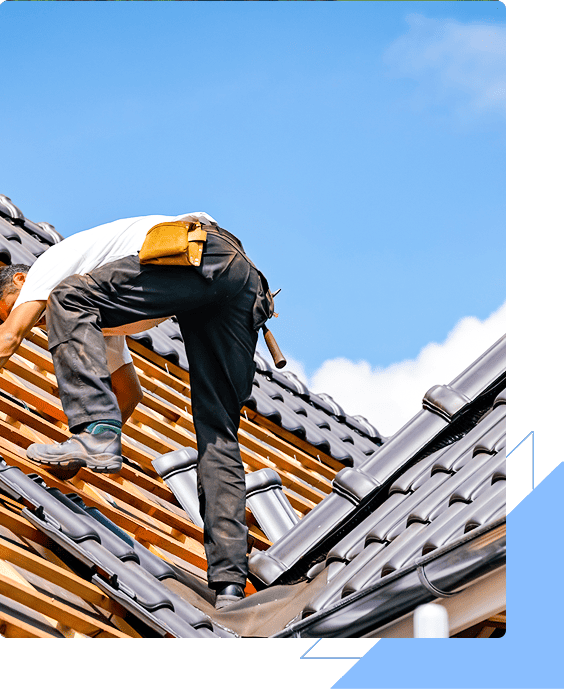DIY roof repair projects are becoming increasingly popular. With the right knowledge and resources, homeowners can save a lot of money by tackling these projects themselves.
However, it is important to remember that there are certain dos and don’ts when attempting roof repairs on your own. This article provides tips from experienced professionals to help ensure success in any DIY project related to roof repair.
Readers will be provided with insights into what they should do, as well as mistakes they should avoid making when engaging in such an endeavor. In this way, readers may gain valuable information which could potentially prevent costly damages or delays down the road.
Assessing The Damage
Assessing the damage done to a roof is an important step in determining the course of DIY roof repair. Identifying signs of wear and tear, such as missing shingles or cracked tiles, is essential for developing a plan for successful restoration.
It is also important to consider any underlying causes that may have contributed to the damage; these can include age-related deterioration, poor installation, inadequate ventilation, or extensive weather exposure.
An accurate assessment of the cost involved in repairs should be taken into account before beginning work. This includes material costs, labor expenses, additional equipment needed (e.g., ladders), and other potential fees associated with certain permits or regulations if applicable.
Taking time upfront to understand all aspects of the project will help ensure success when it comes time for actual implementation. To sum up, careful consideration of both existing conditions and potential outlays are integral parts of a comprehensive strategy for effective DIY roof repair.
Understanding The Scope Of The Project
Once the extent of the damage has been assessed, it is time to understand the scope of the project. This involves identifying what needs to be done and gauging how much that will cost in terms of both money and effort. Knowing this will help you plan your repair job for maximum efficiency and accuracy.
A qualified roofer should always inspect a DIY roof repair before any materials are purchased or labor begins. They can provide an accurate picture of what repairs are necessary as well as an estimate on costs associated with them. Additionally, they may suggest ways to save money without sacrificing quality by recommending substitutes for more expensive materials.
Furthermore, they can offer advice about tools needed to complete the job efficiently so that all aspects of the roofing system receive attention.
Having a clear understanding of these elements allows homeowners to make informed decisions about their roof repair projects, ensuring successful results in lieu of costly mistakes down the road. Taking time to review available options and weigh each one carefully enables homeowners to feel confident when tackling their own repairs instead of relying solely on professional assistance.
Securing The Necessary Supplies And Tools
Securing the necessary supplies and tools to complete a DIY roof repair is an essential part of the process.
Gathering materials such as shingles, nails, weatherproof sealants, and plywood should be done prior to starting any repairs. When selecting these items it is important to get good quality products that will last over time and withstand various climates.
In addition, one may need to rent special equipment for more complex projects; this could include ladders, scaffolding or saws. Having appropriate safety gear on hand is also recommended when using rented power tools or working at high elevations.
Properly gathering all supplies and tools before beginning a project can save time in the long run and help ensure successful results.
Ensuring Safety Precautions
As with any DIY project, roof repair is not to be taken lightly. Ensuring safety precautions must be an essential part of the process, as working on a roof can present potential dangers if proper care and attention are not taken.
Evaluating risk should never be overlooked, especially when considering materials that may require special tools or techniques for installation. Prior planning is vital in order to determine what steps need to be taken during the repair in order to ensure safe handling and use of both equipment and materials.
It is important to remember that many types of roofing material have specific weights and requirements which may necessitate additional support from either plywood sheathing or structural components such as beams or trusses. If there is any doubt about whether the surface can adequately provide support for these items, it might be better to seek out professional assistance before proceeding with repairs.
A little extra caution now could save a great deal of trouble down the road. With this in mind, taking time to evaluate all available options will help prepare you for success when completing your DIY roof repair project.
Familiarizing Yourself With The Process
Before embarking on a DIY roof repair project, it is important to familiarize yourself with the process. This involves gathering information about the type of materials and tools needed for the job as well as understanding what steps are involved in making sure that the repair is done safely and correctly.
When choosing materials for your roof repair project, be sure to take into account factors such as weather conditions, climate, building codes, and any other safety regulations in order to ensure that everything complies with local standards.
Additionally, make sure you also know how long each material will last so you can determine which one best meets your needs.
In addition to this knowledge base, researching step-by-step instructions from experienced professionals or reliable sources online may prove beneficial when starting out.
With these tips in mind, you should now be ready to begin your DIY roof repair project with confidence!
Following Instructions Carefully
Following instructions carefully is essential to successful roof repair.
Careful reading of the directions and researching the materials needed can help ensure that each step in the process is completed correctly.
Knowing what tools are necessary and having them on hand ahead of time will also save time and frustration during a DIY roof repair project.
It is helpful to begin by reviewing any safety information provided, as well as become familiar with proper lifting techniques for heavy items like shingles or tiles used in the repair.
Taking the time up front to be prepared can reduce the risk of injury or damage during a job.
Any additional questions should be directed towards an expert source such as a hardware store or contractor who specializes in roofs before attempting any repairs.
This way, important details won’t be overlooked and the entire process can go more smoothly.
With careful preparation and attention to detail, even novice DIYers may find themselves feeling confident enough to tackle small-scale roof repairs without assistance from a professional.
Seeking Professional Assistance When Needed
It is important to remember that DIY roof repair tasks, although possible for the handyman or woman with a few tools, can be time consuming and require a level of expertise.
Furthermore, there are cost implications associated with this type of project that must be taken into account prior to undertaking such an endeavor.
As such, it may ultimately be more prudent to seek assistance from a professional in some cases.
By enlisting the help of a skilled contractor who has extensive experience in roof repairs and maintenance, homeowners will not only receive assurance that the job has been completed correctly but they will also save themselves both significant amounts of time and money when compared to attempting such projects on their own.
The peace-of-mind provided by engaging expert services should outweigh any other considerations.
Conclusion
It is essential to assess the damage before beginning a DIY roof repair project.
Understanding the scope of the project, securing necessary supplies and tools, ensuring safety precautions, familiarizing oneself with the process, following instructions carefully, and seeking professional assistance when needed are all key components to consider for success.
By taking these steps and being aware of any risks involved, one can avoid costly mistakes that may lead to further damage or injury.
With proper preparation and knowledge, DIY roof repairs can be done in an effective manner by both experienced professionals and novice handymen alike.




















